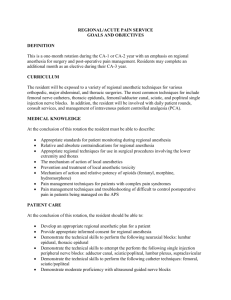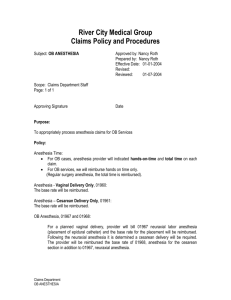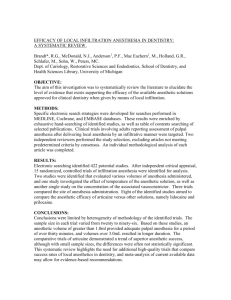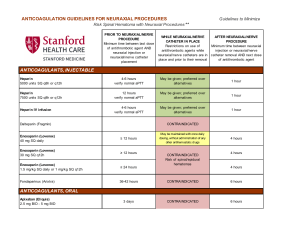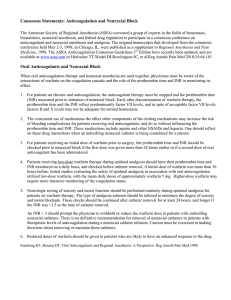Acute Pain
advertisement
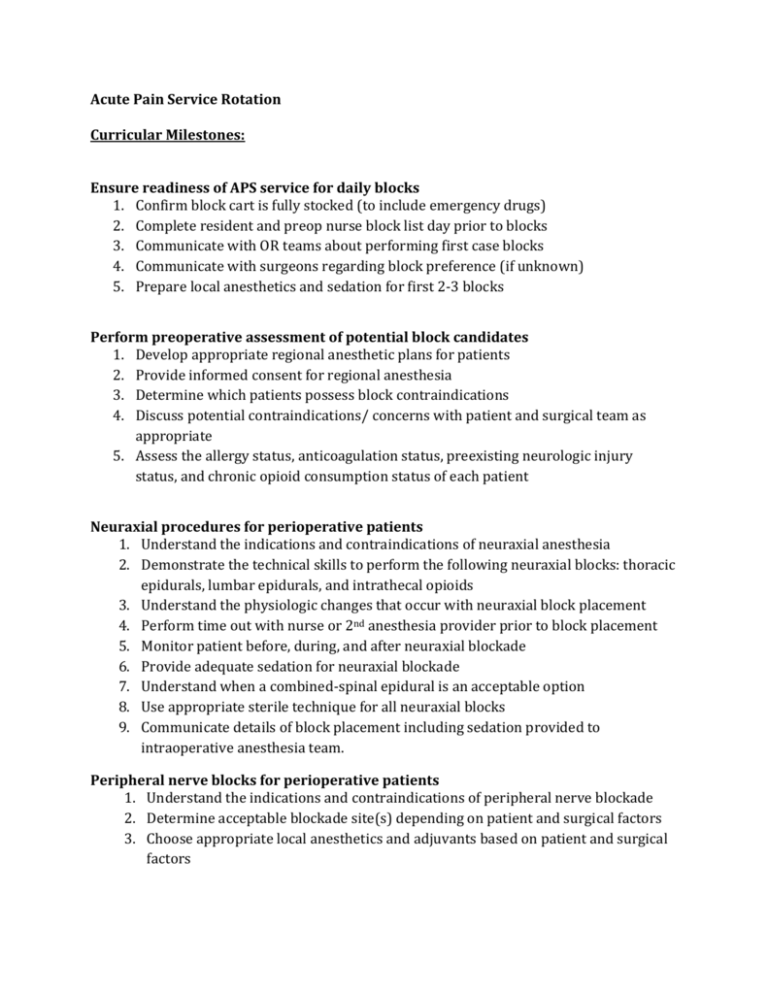
Acute Pain Service Rotation Curricular Milestones: Ensure readiness of APS service for daily blocks 1. Confirm block cart is fully stocked (to include emergency drugs) 2. Complete resident and preop nurse block list day prior to blocks 3. Communicate with OR teams about performing first case blocks 4. Communicate with surgeons regarding block preference (if unknown) 5. Prepare local anesthetics and sedation for first 2-3 blocks Perform preoperative assessment of potential block candidates 1. Develop appropriate regional anesthetic plans for patients 2. Provide informed consent for regional anesthesia 3. Determine which patients possess block contraindications 4. Discuss potential contraindications/ concerns with patient and surgical team as appropriate 5. Assess the allergy status, anticoagulation status, preexisting neurologic injury status, and chronic opioid consumption status of each patient Neuraxial procedures for perioperative patients 1. Understand the indications and contraindications of neuraxial anesthesia 2. Demonstrate the technical skills to perform the following neuraxial blocks: thoracic epidurals, lumbar epidurals, and intrathecal opioids 3. Understand the physiologic changes that occur with neuraxial block placement 4. Perform time out with nurse or 2nd anesthesia provider prior to block placement 5. Monitor patient before, during, and after neuraxial blockade 6. Provide adequate sedation for neuraxial blockade 7. Understand when a combined-spinal epidural is an acceptable option 8. Use appropriate sterile technique for all neuraxial blocks 9. Communicate details of block placement including sedation provided to intraoperative anesthesia team. Peripheral nerve blocks for perioperative patients 1. Understand the indications and contraindications of peripheral nerve blockade 2. Determine acceptable blockade site(s) depending on patient and surgical factors 3. Choose appropriate local anesthetics and adjuvants based on patient and surgical factors 4. Demonstrate the technical skills to perform the following single injection peripheral nerve blocks: femoral, infragluteal sciatic, popliteal fossa, lumbar plexus, interscalene, supraclavicular, and infraclavicular 5. Demonstrate the technical skills to perform the following catheter techniques: interscalene, infraclavicular, femoral, and popliteal fossa 6. Demonstrate the technical skills to perform the following truncal blocks: paravertebral and TAP blocks 7. Demonstrate moderate proficiency with ultrasound guided nerve blocks 8. Understand when nerve stimulation is appropriate/ beneficial Demonstrate knowledge and use of common acute pain/regional medications 1. Understand the pharmacology of commonly used local anesthetics 2. Understand the pharmacology and relative potency of both systemic and neuraxial opioids (fentanyl, morphine, hydromorphone) 3. Understand the pharmacology of local anesthetic adjuvants 4. Understand and be prepared to treat side effects of neuraxial and regional anesthetic adjuvant medications including opioids Manage the daily activities of the acute pain service 1. Ensure that all acute pain orders are completed in a timely fashion 2. Complete all preoperative orders prior to the day of surgery 3. Communicate with intraoperative anesthesia team plan for epidural if timing requires placement in OR 4. Discuss and utilize techniques for consults regarding patients with complex pain syndromes 5. Carry and respond appropriately to the acute pain pager during assigned shifts 6. Perform appropriate patient care handoff / pager handoff when shift is complete 7. Assist acute pain nurse with weekday pain rounds and perform independent weekend pain rounds 8. Assess patients in recovery room to determine efficacy of acute treatment Coordinate patient care within acute pain environment 1. Be respectful of patients, families, and other members of health care team 2. Be responsible, punctual, and responsive to pages 3. Acknowledge errors, self-assess 4. Be honest, ethical, and moral 5. Communicate effectively with preop nurses, acute pain colleagues, and surgeons 6. React to stressful situations in an appropriate manner 7. Utilize anesthesia techs and preop nurses in a reasonable fashion Emergency Situations 1. Understand the potential for toxicity of commonly administered regional block medications 2. Respond appropriately to acute complications of neuraxial placement 3. Understand the prevention, clinical presentation and treatment of local anesthetic toxicity 4. Be prepared to acquire and properly administer intralipid when necessary 5. Understand and prioritize management of a patient who experiences local anesthetic toxicity
